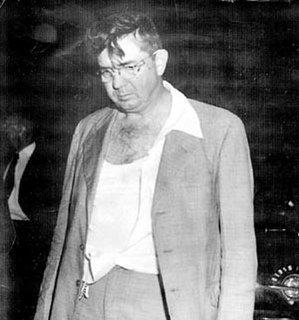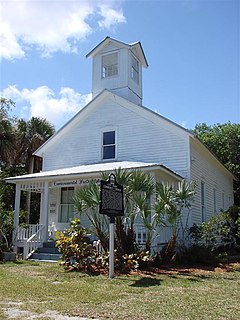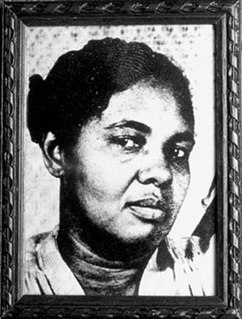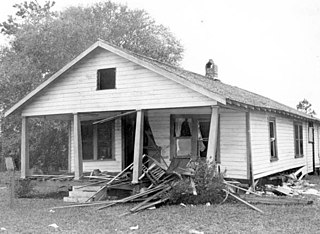
Brevard County is located in the east central portion of the U.S. state of Florida. As of the 2020, the population was 606,392, making it the 10th most populated county in Florida. The official county seat has been located in Titusville since 1894. Brevard County comprises the Palm Bay–Melbourne–Titusville, FL Metropolitan Statistical Area. It is located along the east Florida coast and bordered by the Atlantic Ocean.

Cocoa is a city in Brevard County, Florida. The population was 19,041 at the 2020 United States Census. It is part of the Palm Bay–Melbourne–Titusville Metropolitan Statistical Area.

Mims is a census-designated place (CDP) in Brevard County, Florida. The population was 7,058 at the 2010 United States Census. It is part of the Titusville, Florida Metropolitan Statistical Area.
Brevard Public Schools is a school district serving Brevard County, Florida, and based in Viera, Florida.

Harry Tyson Moore was an African-American educator, a pioneer leader of the civil rights movement, founder of the first branch of the National Association for the Advancement of Colored People (NAACP) in Brevard County, Florida, and president of the state chapter of the NAACP.

Willis Virgil McCall was sheriff of Lake County, Florida. He was elected for seven consecutive terms from 1944 to 1972. He gained national attention in the Groveland Case in 1949. In 1951, he shot two defendants in the case while he was transporting them to a new trial and killed one on the spot. Claiming self-defense, he was not indicted for this action. He also enforced anti-miscegenation laws and was a segregationist.
Cocoa High School is a junior/senior high school located in Cocoa, Florida, and is part of the Brevard Public Schools District. The principal is Rachad Wilson.

The City Point Community Church is a historic church in Cocoa, Florida, United States. It is located at 3783 North Indian River Drive.
Brevard County, Florida provides a number of unique services to help the aged, juveniles, the physically and mentally handicapped, and minorities.

Harriette Vyda Simms Moore was an American educator and civil rights worker. She was the wife of Harry T. Moore, who founded the first branch of the National Association for the Advancement of Colored People (NAACP) in Brevard County, Florida. The murder of the Moores was the first assassination to happen during the Civil Rights Movement and the only time both a husband and a wife were killed for their activism.

Black schools, also referred to as "colored" schools, were racially segregated schools in the United States that originated after the American Civil War and Reconstruction era. The phenomenon began in the late 1860s during Reconstruction era when Southern states under biracial Republican governments created public schools for the ex enslaved. They were typically segregated. After 1877, conservative whites took control across the South. They continued the black schools, but at a much lower funding rate than white schools.
Suwannee River Junior College, located in Madison, Florida, opened in 1959. It was one of eleven black junior colleges founded in the late 1950s at the initiative of the Florida Legislature. Since racial integration in schools was prohibited in the Florida Constitution of 1885 then in effect, the Legislature wished to avoid the integration mandated in the unanimous Brown v. Board of Education Supreme Court decision of 1954 by demonstrating that a "separate but equal" higher education system existed in Florida for African Americans.
The History of Brevard County can be traced to the prehistory of native cultures living in the area from pre-Columbian times to the present age. Brevard County is a county in the U.S. state of Florida, along the coast of the Atlantic Ocean. The geographic boundaries of the county have changed significantly since its founding. The county is named for Judge Theodore W. Brevard, an early settler, and state comptroller, and was originally named St. Lucie County until 1855. The official county seat has been located in Titusville since 1894, although most of the county's administration is performed from Viera.

Eastern Florida State College, formerly Brevard Community College, is a public college in Brevard County, Florida. It is a member of the Florida College System and has campuses in Cocoa, Melbourne, Palm Bay, and Titusville, as well as a Virtual Campus. EFSC is a direct connect satellite campus program to The University of Central Florida (UCF) in Orlando, Florida.
Jackson Junior College, in Marianna, Florida, county seat of Jackson County, opened its doors in 1961. It was one of eleven black junior colleges founded in the late 1950s at the initiative of the Florida Legislature. Since racial integration in schools was prohibited in the Florida Constitution of 1885 then in effect, the Legislature wished to avoid the integration mandated in the unanimous Brown v. Board of Education Supreme Court decision of 1954 by demonstrating that a "separate but equal" higher education system existed in Florida for African Americans. Support by local African Americans, who wanted integration, was unenthusiastic.
Carver Junior College, in Cocoa, Florida, was established by the Brevard County Board of Public Instruction in 1960 to serve black students, at the same time that it founded Brevard Junior College, now Eastern Florida State College, for white students. It was named for the black agricultural researcher George Washington Carver. Like 10 of Florida's other 11 black junior colleges, it was founded as a result of a 1957 decision by the Florida Legislature to preserve racial segregation in education, mandated under the 1885 Constitution that was in effect until 1968. More specifically, the Legislature wanted to show, in response to the unanimous Supreme Court decision mandating school integration, that the older standard of "separate but equal" educational facilities was still viable in Florida. Prior to this legislative initiative, the only publicly funded colleges for negro or colored students were Florida A&M University, in Tallahassee, and Booker T. Washington Junior College, in Pensacola.
Rosenwald Junior College, located in Panama City, Florida, opened its doors in 1958. It was one of eleven black junior colleges founded in the late 1950s at the initiative of the Florida Legislature. Since racial integration in schools was prohibited by the Florida Constitution of 1885 then in effect, the Legislature wished to avoid the integration mandated in the unanimous Brown v. Board of Education Supreme Court decision of 1954 by demonstrating that a "separate but equal" higher education system existed in Florida for African Americans.
Volusia County Community College, located at 875 Second Avenue in Daytona Beach, Florida, opened its doors in 1958. It was one of twelve black junior colleges founded in the late 1950s at the initiative of the Florida Legislature. Since racial integration in schools was prohibited in the Florida Constitution of 1885 then in effect, the Legislature wished to avoid the integration mandated in the unanimous Brown v. Board of Education Supreme Court decision of 1954 by demonstrating that a "separate but equal" higher education system existed in Florida for African Americans.

Harry T. Moore and his wife, Harriette V. S. Moore, were pioneer activists and leaders of the early Civil Rights Movement in the United States and became the first martyrs of the movement. On the night of Christmas, December 25, 1951, a bomb that had been planted under the bedroom floor of the Moores' home in Mims, Florida, exploded. They had celebrated their 25th wedding anniversary earlier that day. Harry died in the ambulance in transit from the attack, and Harriette died from her injuries nine days later, on January 3, 1952. Their murder was the first assassination of any activist to occur during the Civil Rights Movement and the only time that a husband and wife were murdered during the history of the movement.

Moore Memorial Park and Cultural Center is a historic site in Mims, Florida. The site, which was the home of civil rights leader Harry T. Moore, now houses a museum, conference center and park.













